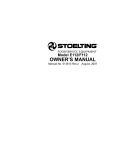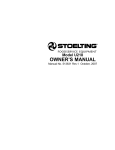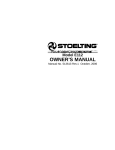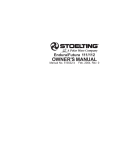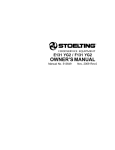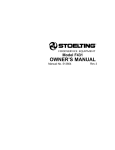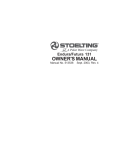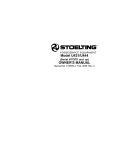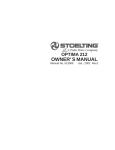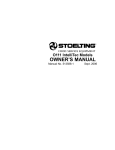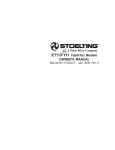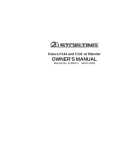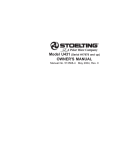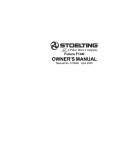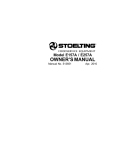Download Model E112/F112 OWNER`S MANUAL
Transcript
Model E112/F112 OWNER’S MANUAL Manual No. 513613 Rev.2 August, 2007 Owner's Manual For E112 and F112 Stoelting Counter Model Gravity Freezer Shake and Frozen Beverage This manual provides basic information about the freezer. Instructions and suggestions are given covering its operation and care. The illustrations and specifications are not binding in detail. We reserve the right to make changes to the freezer without notice, and without incurring any obligation to modify or provide new parts for freezers built prior to date of change. DO NOT ATTEMPT to operate the freezer until instructions and safety precautions in this manual are read completely and are thoroughly understood. If problems develop or questions arise in connection with installation, operation, or servicing of the freezer, contact the company at the following location: STOELTING, LLC 502 Hwy. 67 Kiel, WI 53042 Ph: 800-558-5807 Fax: 920-894-7029 A Few Words About Safety Safety Information Read and understand the entire manual before operating or maintaining Stoelting equipment. This Owner's Manual provides the operator with information for the safe operation and maintenance of Stoelting equipment. As with any machine, there are hazards associated with their operation. For this reason safety is emphasized throughout the manual. To highlight specific safety information, the following safety definitions are provided to assist the reader. The purpose of safety symbols is to attract your attention to possible dangers. The safety symbols, and their explanations, deserve your careful attention and understanding. The safety warnings do not by themselves eliminate any danger. The instructions or warnings they give are not substitutes for proper accident prevention measures. If you need to replace a part, use genuine Stoelting parts with the correct part number or an equivalent part. We strongly recommend that you do not use replacement parts of inferior quality. Safety Alert Symbol: This symbol Indicates danger, warning or caution. Attention is required in order to avoid serious personal injury. The message that follows the symbol contains important information about safety. Signal Word: Signal words are distinctive words used throughout this manual that alert the reader to the existence and relative degree of a hazard. WARNING The signal word “WARNING” indicates a potentially hazardous situation, which, if not avoided, may result in death or serious injury and equipment/property damage. CAUTION The signal word “CAUTION” indicates a potentially hazardous situation, which, if not avoided, may result in minor or moderate injury and equipment/property damage. CAUTION The signal word “CAUTION” not preceded by the safety alert symbol indicates a potentially hazardous situation, which, if not avoided, may result in equipment/property damage. NOTICE The signal word “NOTICE” indicates information or procedures that relate directly or indirectly to the safety or personnel or equipment/property. TABLE OF CONTENTS Section Description Page 1 Description and Specifications 1.1 Description ................................................................................................. 1 1.2 Specifications ............................................................................................. 2 2 Installation Instructions 2.1 Safety Precautions ..................................................................................... 5 2.2 Shipment and Transit ................................................................................. 5 2.3 Freezer Installation .................................................................................... 5 3 Initial Set-Up and Operation 3.1 Operator’s Safety Precautions ................................................................... 7 3.2 Operating Controls and Indicators ............................................................. 7 3.3 Sanitizing ................................................................................................... 8 3.4 Freeze Down and Operation ...................................................................... 9 3.5 Mix Information .......................................................................................... 9 3.6 Removing Mix From Freezer ..................................................................... 10 3.7 Cleaning the Freezer ................................................................................. 10 3.8 Disassembly of Freezer Parts .................................................................... 10 3.9 Cleaning the Freezer Parts ........................................................................ 11 3.10 Sanitize Freezer and Freezer Parts ........................................................... 11 3.11 Assembly of Freezer .................................................................................. 11 3.12 Routine Cleaning ....................................................................................... 12 3.13 Preventative Maintenance .......................................................................... 12 3.14 Extended Storage ...................................................................................... 15 4 Troubleshooting 4.1 Light Indicators .......................................................................................... 17 4.2 Troubleshooting ......................................................................................... 17 5 Replacement Parts 5.1 Decals and Lubrication .............................................................................. 19 5.2 Auger Shaft and Faceplate Parts ............................................................... 20 5.3 Hopper Parts .............................................................................................. 22 5.4 Autofill Options ........................................................................................... 23 SECTION 1 DESCRIPTION AND SPECIFICATIONS 1.1 DESCRIPTION The Stoelting E112/F112 counter freezers are gravity fed. The freezers are equipped with fully automatic controls to provide a uniform product. They will operate with almost any type of shake or frozen beverage mix. This manual is designed to help qualified service personnel and operators with the installation, operation and maintenance of the Stoelting E112/F112 gravity freezers. Figure 1-1 Model E112 Figure 1-1 Model F112 1 1.2 SPECIFICATIONS E112 F112 Figure 1-2 Freezer Specifications 2 1.2 SPECIFICATIONS - CONTINUED Model E112 Model F112 Dimensions Freezer with crate Freezer with crate width height 15-1/4'' (38,7 cm) 30-1/2'' (77,5 cm) 17-1/2'' (44,5 cm) 35'' (88,9 cm) 17-1/4'' (43,7 cm) 33'' (83,7 cm) 29'' (73,7 cm) 44'' (111,7 cm) depth Weight 32'' (81,2 cm) 36-1/2'' (92,7 cm) 30-1/4'' (76,7 cm) 39'' (99,0 cm) 205 lbs (92,1 kg) 215 lbs (97,5 kg) 1 Phase, 115 VAC, 60Hz approximately 16A 288 lbs (130,5 kg) 315 lbs (142,9 kg) 1 Phase, 208-230 VAC, 60Hz approximately 10A NEMA5-20P power cord provided NEMA6-20P power cord provided 6,000 Btu/hr 1/3 hp 8,600 Btu/hr 3/4 hp Air Flow Air cooled units require 3" (7,6 cm) air space on both sides or 4" (10,2 cm) air space in back for side-by-side installation Air cooled units require 6" (15,24 cm) air space on both sides Plumbing Fittings N/A Hopper Volume Freezing Cylinder Volume Production Capacity 3.625 gallon (13,73 liters) Water cooled units require 3/8" N.P.T. water and drain fittings. 5.375 gallon (20,35 liters) 1.25 gallon (5 quart), 4,73 liters 2.125 gallon (8.5 quart), 8,04 liters 12 GPH (45,42 liters) 18 GPH (68,15 liters) Electrical running amps connection type Compressor Drive Motor 3 4 SECTION 2 INSTALLATION INSTRUCTIONS 2.1 SAFETY PRECAUTIONS Do not attempt to operate the freezer until the safety precautions and operating instructions in this manual are read completely and are thoroughly understood. Take notice of all warning labels on the freezer. The labels have been put there to help maintain a safe working environment. The labels have been designed to withstand washing and cleaning. All labels must remain legible for the life of the freezer. Labels should be checked periodically to be sure they can be recognized as warning labels. If danger, warning or caution labels are needed, indicate the part number, type of label, location of label, and quantity required along with your address and mail to: Figure 2-2 Space and Ventilation Requirements STOELTING, INC. ATTENTION: Customer Service 502 Hwy. 67 Kiel, Wisconsin 53042 D. 2.2 SHIPMENT AND TRANSIT The freezer has been assembled, operated and inspected at the factory. Upon arrival at the final destination, the entire freezer must be checked for any damage which may have occurred during transit. Correct ventilation is required. The E112 requires 3” clearance on both sides. If the freezer is placed side-by-side next to other equipment, there needs to be at lease 4” clearance at the back of the freezer. The air-cooled F112 requires 6” clearance on both sides for proper air flow. CAUTION Failure to provide adequate ventilation will void warranty. With the method of packaging used, the freezer should arrive in excellent condition. THE CARRIER IS RESPONSIBLE FOR ALL DAMAGE IN TRANSIT, WHETHER VISIBLE OR CONCEALED. Do not pay the freight bill until the freezer has been checked for damage. Have the carrier note any visible damage on the freight bill. If concealed damage and/or shortage is found later, advise the carrier within 10 days and request inspection. The customer must place claim for damages and/or shortages in shipment with the carrier. Stoelting, Inc. cannot make any claims against the carrier. D. Connect the drip tray bracket by loosening the two screws at the front of the freezer. Install the bracket so that it rests on the nylon washer between the two metal washers. Tighten the screws. 2.3 FREEZER INSTALLATION Installation of the freezer involves moving the freezer close to its permanent location, removing all crating, setting in place, assembling parts, and cleaning. A. Uncrate the freezer. B. Accurate leveling is necessary for correct drainage of freezer barrel and to insure correct overrun. Place a bubble level on top of the freezer at each corner to check for level condition. If adjustment is necessary, level the freezer by turning the bottom part of each leg in or out. C. The F112 has a base gasket that must be installed. Separate the gasket and install it with the seam to the back. Make sure the angled side of the gasket is facing up. Figure 2-3 Drip Tray Bracket E. 5 The freezer leaves the factory with the control board set for slush. Contact a service technician to properly set the freezer for shake. WARNING Do not alter or deform electrical plug in any way. Altering the plug to fit into an outlet of different configuration may cause fire, risk of electrical shock, product damage and will void warranty. F. Place the CLEAN-ON-OFF switch in the OFF position. E. Connect the power cord to the proper power supply. The plug on the E112 is designed for 115 volt / 20 amp duty and the plug on the F112 is designed for 208 or 230 volt / 20 amp duty. Check the nameplate on your freezer for proper supply. The unit must be connected to a properly grounded receptacle. The electrical cord furnished as part of the freezer has a three prong grounding type plug. The use of an extension cord is not recommended, if necessary use one with a size 12 gauge or heavier with ground wire. Do not use an adapter to get around grounding requirement. 6 SECTION 3 INITIAL SET-UP AND OPERATION 3.1 OPERATOR’S SAFETY PRECAUTIONS 3.2 OPERATING CONTROLS AND INDICATORS SAFE OPERATION IS NO ACCIDENT; observe these rules: Before operating the freezer, it is required that the operator know the function of each operating control. Refer to Figure 3-1 for the location of the operating controls on the freezer. A. Know the freezer. Read and understand the Operating Instructions. B. Notice all warning labels on the freezer. C. Wear proper clothing. Avoid loose fitting garments, and remove watches, rings or jewelry that could cause a serious accident. D. Maintain a clean work area. Avoid accidents by cleaning up the area and keeping it clean. E. Stay alert at all times. Know which switch, push button or control you are about to use and what effect it is going to have. F. Disconnect electrical cord for maintenance. Never attempt to repair or perform maintenance on the freezer until the main electrical power has been disconnected. G. Do not operate under unsafe operating conditions. Never operate the freezer if unusual or excessive noise or vibration occurs. WARNING High voltage will shock, burn or cause death. The OFF-ON switch must be placed in the OFF position prior to disassembling for cleaning or servicing. Do not operate machine with cabinet panels removed. A. Spigot Switch The spigot switch will automatically start the auger drive and refrigeration systems when the spigot is opened to dispense product. When the spigot is closed, the drive motor and compressor will remain on until the product in the freezing cylinder reaches the proper consistency.. Consistency Adjustment Knob Diagnostic Light Add Mix Indicator Clean/Off/On Switch Figure 3-1 Freezer Controls 7 B. CLEAN-OFF-ON Switch H. The CLEAN-OFF-ON switch is used to supply power to the control circuit. When the switch is in the OFF (middle) position, power will not be supplied to the control board or refrigeration system. When the switch is in the ON position, the freezer will operate in the freezing mode. When the switch is in the CLEAN position, all refrigeration will stop and the auger will start rotating. C. The light kit is installed behind the header panel and illuminates a translucent header panel. I. ADD MIX Light J. 3.3 SANITIZING Failure to refill hopper immediately may result in operational problems. Sanitizing must be done after the freezer is cleaned and just before the hopper is filled with mix. Sanitizing the night before is not effective. However, you should always clean the freezer and parts after each use. Diagnostic Light The Diagnostic Light will flash if an error occurs. The light will flash once if there is a compressor error. There will be two quick flashes if there is an auger error. And there will be three quick flashes if the freezer is left in clean mode for more than 20 minutes. Refer to the troubleshooting section for details. The United States Department of Agriculture and the Food and Drug Administration require that all cleaning and sanitizing solutions used with food processing equipment be certified for this use. When sanitizing the freezer, refer to local sanitary regulations for applicable codes and recommended sanitizing products and procedures. The frequency of sanitizing must comply with local health regulations. Consistency Adjustment Knob The Consistency Adjustment Knob increases or decreases product consistency. A tension spring is connected to the knob and changes the amount of torque needed to complete a refrigeration cycle. Turn the knob clockwise to increase consistency or counterclockwise to decrease consistency. Mix sanitizer according to manufacturer’s instructions to provide a 100 parts per million strength solution. Mix sanitizer in quantities of no less than 2 gallons (7.5 liters) of 90° to 110°F (32° to 43°C) water. Allow sanitizer to contact the surfaces to be sanitized for 5 minutes. Any sanitizer must be used only in accordance with the manufacturer’s instructions. NOTE An additional spring is included with the freezer behind the header panel. The additional spring can be installed for use with shake mixes when a higher consistency is required. Do not use the optional spring with slush mixes. F. In general, sanitizing may be conducted as follows: CAUTION Front Door Safety Switch Do not allow sanitizer to remain in contact with stainless steel freezer parts for prolonged periods. Prolonged contact of sanitizer with freezer may cause corrosion of stainless steel parts. The front door safety switch prevents the auger from turning when the front door is removed. The switch is open when the door is not in place and closed when the door is properly installed. G. Spinner Kit - Optional (E112 Part 2187103, F112 Part 2187031) The spinner kit is installed on the front of the freezer and offers blended frozen beverages. NOTE E. Bottle Rack Kit - Optional (E112 Part 2187100, F112 Part 2187040 or 2187024) The bottle rack kit is installed onto the header panel and holds 7 flavor bottles (13 bottles on the 2187024). The ADD MIX light will flash to alert the operator to a low mix condition. It does so by monitoring the mix level in the hopper. When the ADD MIX light is flashing, refill hopper immediately. D. Light Kit - Optional (E112 Part 2183800, F112 Part 2187102) Autofill Kit - Optional (E112 Part 2183807, F112 Part 2187101) A. Prepare Stera-Sheen Green Label Sanitizer or equivalent according to manufacturer’s instructions to provide a 100 ppm strength solution. Mix the sanitizer in quantities of no less than 2 gallons of 90° to 110°F (32° to 43°C) water. Any sanitizer must be used only in accordance with the manufacturer’s instructions. B. If using a shake mix, place the mix inlet regulator into hopper. If using a slush mix, the mix inlet regulator is not required. The autofill kit is used with a pump to keep the hopper filled. The autofill kit is for use with nonpotentially hazardous food substances; non-dairy. Refer to Section 5-4 for Autofill options. 8 C. Pour approximately 1/2 gallon of fully thawed mix into the hopper. Open spigot and drain a small amount of mix to remove any remaining sanitizer. D. Fill the hopper with pre-chilled (40°F or 4°C) mix. NOTE Do not overfill the hopper. Mix level must not be higher than the air inlet tube on the mix inlet regulator. E. Place the switch in the ON position. NOTE After the drive motor starts, there is a 3 second delay before the compressor starts. Figure 3-2 Sanitizing hopper C. Place the switch in the CLEAN position. Check for leaks. D. Clean sides of hopper, mix inlet regulator and underside of hopper cover using a soft bristle brush dipped in the sanitizing solution (Refer to Figure 3-2). E. After five minutes, place a bucket under the spigot and open spigot to drain sanitizing solution. Place the switch in the OFF (middle) position. Loosen freezer door and allow the freezing cylinder to drain completely. Re-tighten door. F. After 8 to 12 minutes the product will be at consistency and will be ready to serve. Freeze down time may vary depending on mix type and ambient temperatures. G. To dispense, pull the spigot handle down to open the spigot. H. The freezer is designed to dispense the product at a reasonable draw rate. If the freezer is overdrawn, the result is a soft product or a product that will not dispense at all. If this should occur, allow the freezer to run for approximately 30 seconds before dispensing additional product. I. Do not operate the freezer when the ADD MIX light is on. Refill the hopper immediately. 3.5 MIX INFORMATION Mix can vary considerably from one manufacturer to another. Differences in the amount of butterfat content and quantity and quality of other ingredients have a direct bearing on the finished frozen product. A change in freezer performance that cannot be explained by a technical problem may be related to the mix. Proper product serving temperature varies from one manufacturer’s mix to another. Shake and stackable slush mixes provide satisfactory product from 24° to 28°F (-4° to -2°C). Figure 3-3 Mix Inlet Regulator When checking the temperature, stir the thermometer in the frozen product to obtain an accurate reading. 3.4 FREEZE DOWN AND OPERATION Old mix or mix that has been stored at elevated temperatures will produce poor-quality product with a bad taste and unacceptable appearance. To retard bacteria growth in dairy based mixes, the best storage temperature range is between 33° to 38°F (0.5° to 3.3°C). This section covers the recommended operating procedures for the safe operation of the freezer. A. Sanitize just prior to use. B. Place the switch in the OFF (middle) position. Some shake mixes tend to foam more than others. If foam appears in the hopper, skim off with a sanitized utensil and discard. Periodically, stir the mix in the hopper with a sanitized utensil to help prevent excess foam. NOTE Make sure the mix inlet regulator is in place before adding shake mixes. This is not necessary for slush mixes. 9 3.6 REMOVING MIX FROM FREEZER To remove the mix from the freezer, refer to the following steps: A. If removing shake mix, pull the mix inlet regulator straight up and remove it from the hopper. B. Place the switch in the CLEAN position to rotate the auger. Allow the mix to agitate in freezing cylinder until the mix has become liquid, about 5 minutes. C. Drain the liquid mix by opening the spigot. A container should be placed under the spigot to collect the liquid mix. D. Figure 3-4 Remove Spigot Pin Place the switch in the OFF (middle) position. A. Remove hopper cover. Remove the mix inlet regulator from the hopper. NOTE B. The frequency of cleaning the freezer and freezer parts must comply with local health regulations. Pull out the spigot pin by its ring (Refer to Figure 3-4). C. Remove the spigot handle. D. Remove front door by turning the circular knobs and then pulling door off the studs. 3.7 CLEANING THE FREEZER After the mix has been removed from the freezer, the freezer must be cleaned. To clean the freezer, refer to the following steps: NOTE A. Close the spigot and fill the hopper with 2 gallons (8 liters) of tap water. B. Place the switch in the CLEAN position. The auger will start to rotate. E. Remove torque rod from stator assembly. C. Allow the water to agitate for approximately 30 seconds. F. Remove quad ring from groove in front door. G. D. Open the spigot to drain the water. Remember to place a container under the spigot to catch the water. When the water has drained, place the switch in the OFF (middle) position. Allow the freezing cylinder to drain completely. Remove stator bar. Remove o-ring and white bushing from stator bar. H. Remove auger support bushing. I. Turn the spigot body until the ice breaker bar can be removed. Remove breaker bar (Refer to Figure 3-5). E. When removing front door, entire door and stator assembly will come out as well. Prepare detergent water by mixing 2 oz. of Palmolive detergent or equivalent in 2 gallons of 90° to 110°F (32° to 43°C) water. Repeat steps A through D using the detergent solution. 3.8 DISASSEMBLY OF FREEZER PARTS Inspection for worn or broken parts should be made each time the freezer is disassembled. All worn or broken parts should be replaced to ensure safety to both the operator and the customer and to maintain good freezer performance and a quality product. Frequency of cleaning must comply with the local health regulations. To disassemble the freezer, refer to the following steps: CAUTION Hazardous Moving Parts. Revolving auger shaft can grab and cause injury. Place the switch in the OFF (middle) position before disassembling for cleaning or servicing. Figure 3-5 Spigot and Ice Breaker Bar Removal 10 brushes provided (Refer to Figure 3-7). C. Clean the rear seal surfaces from the inside of the freezing cylinder with the 90° to 110°F (32° to 43°C) detergent water. 3.10 SANITIZE FREEZER AND FREEZER PARTS CAUTION Do not allow sanitizer to remain in contact with stainless steel freezer parts for prolonged periods. Prolonged contact of sanitizer with freezer may cause corrosion of stainless steel parts. Figure 3-6 Removing O-Ring J. Remove spigot body from the front door. K. Remove o-rings (2) from the spigot by first wiping off the lubricant using a clean paper towel. Then squeeze the o-ring upward with a dry cloth. When a loop is formed, roll the o-ring out of the groove (Refer to Figure 3-6). L. Remove auger assembly from the freezing cylinder and remove auger blades. M. Remove rear seal and o-ring from auger. N. Remove drain tray, drip tray and drip tray grid. A. Use Stera-Sheen or equivalent sanitizing solution mixed according to manufacturer's instructions to provide 100 parts per million strength solution. Mix sanitizer in quantities of no less than 2 gallons (7.5 liters) of 90° to 110°F (32° to 43°C) water. Any sanitizer must be used only in accordance with the manufacturer's instructions. B. With the large brush provided, sanitize the rear of the freezing cylinder by dipping the brush in the sanitizing solution and brushing the rear of the cylinder. 3.9 CLEANING THE FREEZER PARTS 3.11 ASSEMBLY OF FREEZER Place all loose parts in a pan or container and take to the wash sink for cleaning. To clean freezer parts, refer to the following steps: A. B. To assemble the freezer parts, refer to the following steps: NOTE Prepare detergent water by mixing 2 oz. of Palmolive detergent or equivalent in 2 gallons of 90° to 110°F (32° to 43°C) water. Place all parts in detergent solution and clean with provided brushes. Rinse all parts with clean 90° to 110°F (32° to 43°C) water. Petrol Gel sanitary lubricant or equivalent must be used when lubrication of parts is specified. NOTE The United States Department of Agriculture and the Food and Drug Administration require that lubricants used on food processing equipment be certified for this use. Use lubricants only in accordance with the manufacturer’s instructions. Wash the hopper and freezing cylinder with the 90° to 110°F (32° to 43°C) detergent water and Figure 3-7 Cleaning Freezing Cylinder 11 A. Assemble all o-rings onto parts dry, without lubrication. Then apply a thin film of sanitary lubrication to exposed surfaces of the o-rings. Also apply a thin film of sanitary lubricant inside and outside of front auger support bushing, and to the inside and outside of stator support bushing. B. Assemble the rear seal onto the auger with the large end to the rear. Be sure the o-ring is in place before installing the rear seal (Refer to Figure 38). C. Put a small amount of white Hex Drive Anti Seize (spline lube) on the hex end of the auger shaft. A small container of Anti Seize is shipped with the freezer. D. Install the plastic auger blade onto auger. E. F. Push auger into freezing cylinder and rotate slowly until auger engages the drive shaft. CAUTION Insert spigot body into front door. Do not place the mix inlet regulator into the hopper before installing the auger. Attempting to install the auger with the mix inlet regulator in place will damage the regulator. NOTE When inserting spigot body, press o-rings in to prevent damage. G. H. Turn spigot body until the ice breaker bar can be inserted. Insert breaker bar and rotate spigot body 90°. Install auger support bushing onto front door so beveled edge of bushing is against door. I. Install the white stator support bushing onto the rear of the stator bar and insert stator into spigot. J. Insert torque rod. The rod should be placed through the hole in stator bar. K. Install the front door onto the freezer. NOTE When installing door onto freezer, torque rod must be placed in the center of metal torque actuator arm L. Install the knobs on the freezer studs. M. Look for the proper seal between the freezing cylinder, quad ring, and front door N. Insert spigot handle so hole lines up and insert spigot pin. O. Install the mix inlet regulator into the hopper if using shake mix. If using slush mix, the mix inlet regulator is not required. P. Install hopper cover, drain tray, drip tray, and drip tray grid. 3.12 ROUTINE CLEANING To remove spilled or dried mix from the freezer exterior, wash in the direction of the finish with warm soapy water and wipe dry. Do not use highly abrasive materials as they will mar the finish. 3.13 PREVENTIVE MAINTENANCE Stoelting recommends that a maintenance schedule be followed to keep the freezer clean and operating properly. CLEANING AND SANITIZING INFORMATION Special consideration is required when it comes to food safety and proper cleaning and sanitizing. The following information has been compiled by Purdy Products Company, makers of Stera-Sheen Green Label Cleaner/Sanitizer and specifically covers issues for cleaning and sanitizing frozen dessert machines. This information is meant to supplement a comprehensive food safety program. Torque Rod Auger Support Bushing Stator Bar Bushing Stator Bar Stator Bar O-Ring figure 3-9 Door and Stator Assembly 12 Quad Ring SOIL MATERIALS ASSOCIATED WITH FROZEN DESSERT MACHINES PROPER DAILY MAINTENANCE: THE ONLY WAY TO ASSURE FOOD SAFETY AND PRODUCT QUALITY MILKFAT/BUTTERFAT – As components of ice-cream/ frozen custard mix, these soils will accumulate on the interior surfaces of the machine and its parts. Fats are difficult to remove and help attribute to milkstone build-up. Proper daily maintenance can involve a wide variety of products and procedures. Overall, the products and procedures fall into three separate categories. (Please note that this is a brief overview intended for informational purposes only.) MILKSTONE – Is a white/gray film that forms on equipment and utensils that come in contact with dairy products. These films will accumulate slowly on surfaces because of ineffective cleaning, use of hard water, or both. Milkstone is usually a porous deposit, which will harbor microbial contaminants and eventually defy sanitizing efforts. Once milkstone has formed, it is very difficult to remove. Without using the correct product and procedure, it is nearly impossible to remove a thick layer of milkstone. (NOTE: general-purpose cleaners DO NOT remove milkstone.) This can lead to high bacteria counts and a food safety dilemma. 1. CLEANING – This involves draining mix from the freezing cylinder and rinsing the machine with water. Next, a cleaner is run through the machine. Then, the machine is disassembled and removable parts are taken to the sink for cleaning. 2. MILKSTONE REMOVAL – Since almost all cleaners do not have the ability to remove milkstone, the use of a delimer becomes necessary. Although this procedure may not be needed on a daily basis, it will usually follow the cleaning procedure. It requires letting a delimer solution soak in the machine for an extended period of time. Individual parts are also soaked in a deliming solution for an extended period of time (more about delimers in Additional Information). 3. SANITIZING – After the machine has been cleaned and contains no milkstone, the machine is reassembled. Then a FDA-approved sanitizing solution is run through the machine to kill bacteria. The machine is then ready for food preparation. IT IS BEST TO CONTROL MILKSTONE ON A DAILY BASIS BEFORE IT CAN BECOME A SIGNIFICANT FOOD SAFETY PROBLEM. In addition to food safety, milkstone can cause premature wear to machine parts which can add to costs for replacement parts or possibly more expensive repairs if worn machine parts are not replaced once they have become excessively worn. IMPORTANT DIFFERENCES BETWEEN CLEANING AND SANITIZING As a recommended cleaner and sanitizer for your frozen dessert machine, STERA-SHEEN has proven to be one of the best daily maintenance products for: CLEANING vs. SANITIZING It is important to distinguish between cleaning and sanitizing. Although these terms may sound synonymous, they are not. BOTH are required for adequate food safety and proper machine maintenance. CLEANING • Is the removal of soil materials from a surface. • Is a prerequisite for effective sanitizing. • CLEANING – Thorough removal of all solids including butterfat and milk fat. • MILKSTONE REMOVAL – Complete removal of milkstone. • SANITIZING – FDA-approved no rinse sanitizer for food contact surfaces. ADDITIONAL INFORMATION NOTE THE USE OF DELIMERS An UNCLEAN surface will harbor bacteria that can defy sanitizing efforts. A delimer is a strong acid that has the ability to dissolve milkstone. This type of chemical may become necessary once high levels of milkstone have developed. While these products are very effective for removing HIGH levels of milkstone, they are not ideal for two reasons: Bacteria can develop and resist sanitizing efforts within a layer of soil material (milkstone). Thorough cleaning procedures that involve milkstone removal are critical for operators of frozen dessert machines. 1. PRODUCT SAFETY – Strong acids are dangerous chemicals and handling them requires safety 2. MACHINE DAMAGE – Strong acids will attack metal and rubber causing premature wear of parts. The use of a delimer needs to be closely monitored to avoid damage to machine surfaces and parts. SANITIZING • Kills bacteria. • Can be effective on clean surfaces only. NOTE Using a SANITIZER on an unclean surface will not guarantee a clean and safe frozen dessert machine. 13 With proper daily use of STERA-SHEEN or its equivalent, there is no need for the use of a DELIMER. D. DO NOT USE BLEACH The air-cooled condenser is a copper tube and aluminum fin type. Condensing is totally dependent upon airflow. A plugged condenser filter, condenser, or restrictions in the louvered panel will restrict airflow. This will lower the capacity of the system and damage the compressor. • BLEACH HAS ABSOLUTELY NO CLEANING PROPERTIES. • BLEACH IS CORROSIVE. It can and will damage components of the machine causing premature wear and metal corrosion. QUARTERLY Air Cooled The condenser must be kept clean of dirt and grease. The F112 must have a minimum of 6” (15.2 cm) of ventilation on the right and left sides of the unit for free flow of air. The E112 must have 3” (7.6 cm) of ventilation. Make sure the freezer is not pulling over 100° F (37° C) air from other equipment in the area. GENERAL PURPOSE CLEANERS General purpose cleaners do not have the ability to remove milkstone. Milkstone will become a problem if not remedied with additional products and procedures. THE USE OF CHLORINE TEST STRIPS The condenser and condenser filter require periodic cleaning. To clean, refer to the following procedures. “Test strips” are used to determine concentrations of active chlorine in sanitizing solutions. To use the strips, tear off a small portion and submerge it into the sanitizing solution. Then, compare the color change to the color key on the side of the test strip dispenser to determine the approximate chlorine concentration. E112 Air Cooled Condenser Cleaning A. Unscrew the knob located on the underside of the freezer towards the front (Fig. 3-10). The ideal concentration of chlorine needs to be 100 ppm (as stated by the FDA). NOTE Follow the directions on the container for proper concentration. There are two main factors that contribute to falling chlorine concentrations in a sanitizing solution. 1. PRODUCT USE – As the chlorine in the solution is being used, chlorine concentrations fall. 2. TIME – As time passes, small amounts of chlorine “evaporate” from the solution. (That is why you can smell it.) Sanitizing solutions should not be allowed to fall below 100 ppm chlorine. New solutions should be mixed once old solutions become ineffective B. 1. C. 1. 2. Figure 3-10 E112 Condenser Filter Removal DAILY The exterior should be kept clean at all times to preserve the luster of the stainless steel. A mild alkaline cleaner is recommended. Use a soft cloth or sponge to apply the cleaner. WEEKLY Check o-rings and rear seal for excessive wear and replace if necessary. B. Remove the filter bracket and remove the filter. C. Visually inspect the condenser filter for dirt. D. If the filter is dirty, vacuum or brush clean, rinse with clean water and allow to dry before replacing on the freezer. NOTE If the condenser is not kept clean, refrigeration efficiency will be lost. Remove the drip tray by gently lifting up to disengage from the support and pulling out. Clean behind the drip tray and front of the freezer with a soap solution. 14 3.14 EXTENDED STORAGE Refer to the following steps for storage of the freezer over any long period of shutdown time: A. Place the CLEAN-OFF-ON switch in the OFF (middle) position. B. Disconnect (unplug) from the electrical supply source. C. Clean thoroughly with a warm water detergent all parts that come in contact with the mix. Rinse in clean water and dry parts. Do not sanitize. NOTE Do not let the cleaning solution stand in the hopper or in the freezing cylinder during the shutdown period. Figure 3-11 F112 Condenser Filter Removal F112 Air Cooled Condenser Cleaning A. Remove the Phillips head screws from the bottom of the right side panel, and then slide the panel down and out. B. To remove the condenser filter, grasp the top and pull off. Visually inspect for dirt. If the filter is dirty, shake or brush excess dirt off the filter and wash in warm, soapy water. Once the filter is clean rinse thoroughly in warm, clear water and shake dry, taking care not to damage the filter in any way (Fig. 3-11). C. Visually inspect the condenser for dirt by shining a light through the coil from the back (inside) of the condenser. D. If the condenser is dirty, place a wet towel over the front (outside) of the condenser. E. Using a vacuum, carefully clean the condenser coil from the inside and outside of the freezer. A stiff bristled brush may help in releasing debris from between the condenser coils. Water Cooled (F112 only) The water-cooled condenser is a tube and shell type. The condenser needs a cool, clean supply of water to properly cool the freezer, inlet and discharge lines must be 3/8” I.D. minimum. Make sure the freezer is receiving an unrestricted supply of cold, clean water. E. SEMI-ANNUALLY 1. Disconnect the freezer from the power source. 2. Check drive belt for proper tension. Push belt in with one finger, belt should deflect about 3/8". 3. Lubricate condenser fan motor with S.A.E. 20 weight oil. Three to six drops are required. 15 D. Remove, disassemble and clean the front door, mix inlet regulator and auger parts. E. In a water cooled freezer, disconnect water lines and drain water. With a flathead screwdriver, hold the water valve open and use compressed air to clear the lines of any remaining water. 16 SECTION 4 TROUBLESHOOTING 4.1 LIGHT INDICATORS The freezer has two lights that will alert the user if a problem occurs: an ADD MIX light and a Diagnostic Light. The ADD MIX light will flash to alert the operator to a low mix condition. It does so by monitoring the mix level in the hopper. When the ADD MIX light is flashing, refill hopper immediately. The Diagnostic Light will flash if an error occurs. Refer to the chart below for details. Indication Conditions On One Blink Two Blinks Three Blinks Defrost Mode Torque is not met after 20 minutes (22 minutes for shake) Drive current is not sensed Freezer left in clean mode for over 20 minutes N/A Self Correction N/A N/A The freezer attempts to sense drive current with a 3 second pre-stir. If current is sensed, the freezer will return to normal operation. If current is not sensed, the freezer will wait 7 minutes and try to sense current with another 3 second prestir. After the third attempt, the compressor will run on timers. Operation Every 7 minutes the auger will run for 90 seconds. Timers Timers Off N/A Contact Service Technician Contact Service Technician Turn CLEAN-OFF-ON switch to OFF (middle) position then turn the switch to ON. Corrective Action 4.2 TROUBLESHOOTING PROBLEM Freezer does not run. Freezer will not shut off. POSSIBLE CAUSE REMEDY 1. Supply power to freezer. 2. Replace or reset. 3. Turn CLEAN-OFF-ON switch to OFF (middle) position for 15 minutes, then restart. 4. Wait until automatic reset for freezer to start. 5. Assemble front door in place. 1. Power to freezer is off. 2. Blown fuse or tripped circuit. 3. Freeze-up (auger will not turn). 4. High pressure cut-out tripped. 5. Front door not in place. 1. Drive belt failure. 1. Replace drive belt. 2. Consistency temperature setting is too 2. Turn Consistency Adjustment knob counterfirm. clockwise. 3. Refrigeration problem. 3. Check system. (Call distributor for service) 1. Consistency temperature setting is too 1. Turn Consistency Adjustment knob counterProduct is too firm. firm. clockwise. 17 4.2 TROUBLESHOOTING - CONTINUED PROBLEM POSSIBLE CAUSE REMEDY 1. No vent space for free flow of cooling air. 2. Air temperature entering condenser is above 100°F. 3. Condenser is dirty. Product is too soft. 4. Consistency setting too soft. 5. Stabilizers in mix are broken down. 6. Auger is assembled incorrectly. Product does not dispense. 7. Refrigeration problem. 1. No mix in hopper. 2. Mix inlet regulator tube is plugged. 3. Drive motor overload tripped. 1. Fill hopper with mix. 2. Unplug, using small sanitized brush. 3. Wait for automatic reset. (If condition continues, call distributor for service.) 4. Replace drive belt. 5. Turn CLEAN-OFF-ON switch to OFF (middle) position for 15 minutes, then restart. 4. Drive belt failure. 5. Freeze-up (Auger will not turn). 1. Worn drive belt. Drive belt slipping 2. Freeze-up (Auger will not turn). or squealing. 3. Not tensioned properly 1. Replace drive belt. 2. Turn CLEAN-OFF-ON switch to OFF (middle) position for 15 minutes, then restart. 3. Adjust belt tension 1. Auger is assembled incorrectly. Low overrun. Rear auger seal leaks. Front door leaks. 2. 3. 4. 5. 1. A minimum of 6" of vent space required (E112 3"). (See Section 2) 2. Change location or direct hot air away from freezer. 3. Clean. (See Section 3) 4. Turn Consistency Adjustment knob clockwise. 5. Remove mix, clean, sanitize and freeze down with fresh mix. 6. Remove mix, clean, reassemble, sanitize and freeze down. 7. Check system. (Call distributor for service) Mix inlet regulator missing. Mix inlet regulator o-ring missing. Mix inlet regulator air tube blocked. Product breakdown. 1. Remove mix, clean, sanitize, and freeze down with fresh mix. 2. Replace mix inlet regulator. 3. Replace mix inlet regulator o-ring. 4. Clean with sanitized brush. 5. Fill freezer with fresh product. 1. Outside surface of rear auger seal is lubricated. 2. Rear seal missing or damaged. 3. Seal o-ring missing, damaged or installed incorrectly. 4. Worn or scratched auger shaft. 1. Clean lubricant from outside of rear seal, lubricate inside of seal and reinstall. 2. Check or replace. 3. Check. or replace. 1. Front door knobs are loose. 2. Spigot parts are not lubricated. 3. Chipped or worn spigot o-rings. 4. O-rings or spigot installed wrong. 5. Inner spigot hole in front door nicked or scratched. 1. 2. 3. 4. 5. 18 4. Replace auger shaft. Tighten knobs. See Section 3. Replace o-rings. Remove spigot and check o-ring. Replace front door. SECTION 5 REPLACEMENT PARTS 5.1 DECALS AND LUBRICATION Part 208135 208380 208401 324105 324106 324107 324141 324208 324393 324509 324548 324566 324584 324686 324804 324852 324853 508048 508135 Description Brush - 4" X 8" X 16" (Barrel) Brush - 1/4" X 3" X 14" Brush - 1" X 3" X 10" Decal - Caution Electrical Shock Decal - Caution Electrical Wiring Materials Decal - Caution Hazardous Moving Parts Decal - Caution Rotating Blades Decal - Attention Refrigerant Leak Check Decal - Stoelting Swirl Logo Decal - Cleaning Instructions Decal - Adequate Ventilation 6" Decal - Wired According To Decal - Adequate Ventilation 3" Decal - Danger Automatic Start Decal - Domed Stoelting Swirl (Header Panel) Decal - Clean Condenser Filter Decal - Warmer / Colder Lubricant - Spline (2 oz Squeeze Tube) Petrol Gel - 4 oz Tube 19 Quantity E112 F112 1 1 1 1 1 1 1 1 1 1 1 1 1 1 1 1 1 1 1 1 1 1 1 1 1 1 1 1 1 1 1 1 1 1 1 482019 336551 2183447 2187188 624644 624645 2183739 630053 570196 2183099 20 625310 624545 E112 - 2183841 F112 - 2183752 2183444 E112 - 2187059 F112 - 2187225 The part numbers referenced on this page do not include all versions of the E112 and F112. Refer to page 21 to view the complete listing. NOTE E112 - 2183854 F112 - 2183751 624678 666786 5.2 AUGER SHAFT AND FACEPLATE PARTS Part 162165 336546 336551 482019 570196 624545-5 624644-5 624645-5 624678-5 625310 630053 666786 2183099 2183100 2183444 2183445 2183446 2183447 2183448 2183449 2183645 2183739 2183751 2183841 2183854 2187059 2187188 2187189 2187225 Description Blade - Scraper (Ser. #22768 - #23376) Door - Front (Ser. #0 - #23494) Door - Front Knob - Front Door (Black) Pin - Cotterless Clevis (Front Door) O-Ring - Stator Bar (5 Pack) O-Ring - Spigot Body (Bottom) (5 Pack) O-Ring - Spigot Body (Top) (5 Pack) O-Ring - Rear Seal - Black (5 Pack) Quad-Ring - Front Door - Black Rod - Torque Actuator Seal - Rear Auger - Black Breaker Bar - Spigot Body Blade - Scraper (E112 - Ser. #0 - #22767) Bushing - Stator Support (Rear) Stator Bar (E112 - Ser. #0 - #23197) Spigot Body (E112 - Ser. #0 - #23197) Handle Only - Spigot Rod Actuator - Torque (E112 - Ser. #0 - #22767) Bushing - Front Auger Support Rod Actuator - Spigot (E112 - Ser. #0 - #22767) Spigot Body Blade - Scraper Stator Bar (E112 - Ser. #23198 Plus) Blade - Scraper (E112 - Ser. #23377 Plus) Auger Shaft Bushing - Front Auger Support Stator Bar Auger Shaft Quantity E112 F112 2 1 1 1 4 4 1 1 1 1 1 1 1 1 1 1 1 1 1 1 1 1 1 1 2 1 1 1 1 1 1 1 1 1 1 1 1 1 1 1 1 1 1 5.2 AUGER SHAFT AND FACEPLATE PARTS - CONTINUED 21 5.3 HOPPER PARTS E112 - 2183642 F112 - 2183721 624607 314466 695706 695707 695714 417006 744281 744254 Part 314466 417006 624607-5 695706 695707 695714 744254 744273 744281 744601 1183955 2183642 2183721 Description Cover - Hopper Grid - Drip Tray (Metal) O-Ring - Mix Inlet (5 Pack) Spring - Consistency Adjustment (Green) Spring - Consistency Adjustment (Yellow) Spring - Consistency Adjustment (Red) Tray - Drip Tray - Drip (E112 - Ser. #0 - #24586) Tray - Drain (Front) Tray - Drain (Rear) O-Ring Kit Mix Inlet Assembly Mix Inlet Assembly 22 Quantity E112 F112 1 1 1 1 2 2 1 1 (shake only) 1 1 (shake only) 1 1 1 1 1 1 1 1 1 5.4 AUTOFILL OPTIONS The E112 and F112 freezers can easily be configured to use an Autofill System. The Autofill System provides a constant supply of non-dairy mix to the freezer. AUTOFILL KIT An autofill kit is needed to use an Autofill System. The kit includes a solenoid, tubing, and a new hopper cover (the F112 also includes a transformer). See below for the Autofill Kit part numbers. AUTOFILL SYSTEMS There are two Autofill Systems available: the Fill-O-Matic II and the Fill-O-Matic III. See below for details on the Autofill Systems. Fill-O-Matic II The Fill-O-Matic II is powered through an electrical outlet and pumps up to 60 gallons per hour. Fill-O-Matic III The Fill-O-Matic III is powered by gas and pumps up to 45 gallons per hour. Fill-O-Matic II & Fill-O-Matic III Fill-O-Matic II Part Numbers Usage Dimensions Electrical Mix Storage Clean Process Output Autofill System: 4177349 E112 Autofill Kit: 2183807 F112 Autofill Kit: 2187101 For use with non-potentially hazardous food substances; non-dairy L 11-1/2" x W 11-1/2" x H 32-1/2" 115VAC 60Hz 55A power cord provided 15 gallon plastic tank Removable strainer allows for easy cleaning Pumps up to 60 gallons per hour Fill-O-Matic III Part Numbers Usage Dimensions Electrical Mix Storage Clean Process Output Autofill System: 4177370 E112 Autofill Kit: 2183807 F112 Autofill Kit: 2187101 For use with non-potentially hazardous food substances; non-dairy L 11-1/2" x W 11-1/2" x H 27-1/2" No electrical connections required Powered by CO2, Nitrogen or compressed air 15 gallon plastic tank Clean-in-place by pumping solution through hoses Pumps up to 45 gallons per hour 23 24 WARRANTY SOFT SERVE / SHAKE FREEZERS 1. Scope: Stoelting, LLC warrants to the first user (the “Buyer”) that the freezer cylinders, hoppers, compressors, drive motors, speed reducers, augers and auger flights of Stoelting soft serve / shake freezers will be free from defects in materials and workmanship under normal use and proper maintenance appearing within five (5) years, and that all other components of such equipment manufactured by Stoelting will be free from defects in material and workmanship under normal use and proper maintenance appearing within twelve (12) months after the date that such equipment is originally installed. 2. Disclaimer of Other Warranties: THIS WARRANTY IS EXCLUSIVE; AND STOELTING HEREBY DISCLAIMS ANY IMPLIED WARRANTY OF MERCHANTABILITY OR FITNESS FOR PARTICULAR PURPOSE. 3. Remedies: Stoelting’s sole obligations, and Buyer’s sole remedies, for any breach of this warranty shall be the repair or (at Stoelting’s option) replacement of the affected component at Stoelting’s plant in Kiel, Wisconsin, or (again, at Stoelting’s option) refund of the purchase price of the affected equipment, and, during the first twelve (12) months of the warranty period, deinstallation/reinstallation of the affected component from/into the equipment. Those obligations/remedies are subject to the conditions that Buyer (a) signs and returns to Stoelting, upon installation, the Checklist/Warranty Registration Card for the affected equipment, (b) gives Stoelting prompt written notice of any claimed breach of warranty within the applicable warranty period, and (c) delivers the affected equipment to Stoelting or its designated service location, in its original packaging/crating, also within that period. Buyer shall bear the cost and risk of shipping to and from Stoelting’s plant or designated service location. 4. Exclusions and Limitations: This warranty does not extend to parts, sometimes called “wear parts”, which are generally expected to deteriorate and to require replacement as equipment is used, including as examples but not intended to be limited to o-rings, auger seals, auger support bushings and drive belts. All such parts are sold AS IS. Further, Stoelting shall not be responsible to provide any remedy under this warranty with respect to any component that fails by reason of negligence, abnormal use, misuse or abuse, use with parts or equipment not manufactured or supplied by Stoelting, or damage in transit. THE REMEDIES SET FORTH IN THIS WARRANTY SHALLBE THE SOLE LIABILITY STOELTING AND THE EXCLUSIVE REMEDY OF BUYER WITH RESPECT TO EQUIPMENT SUPPLIED BY STOELTING; AND IN NO EVENT SHALL STOELTING BE LIABLE FOR ANY INCIDENTAL OR CONSEQUENTIALDAMAGES, WHETHER FOR BREACH OFWARRANTYOR OTHER CONTRACT BREACH, NEGLIGENCE OR OTHER TORT, OR ON ANY STRICT LIABILITY THEORY.































